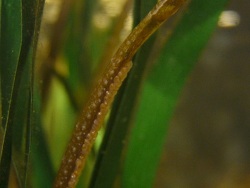Info
Special thanks for the fotos to Rudolf Svensen, Danmark and to Gianni Neto, Italien.
Distribution
Eastern Atlantic: Norway to Morocco (excluding region from Denmark to Netherlands), also throughout the Mediterranean and the Black Sea.
Biology:
Inhabit algal zone or eel-grass (Zostera).
Adults spawn in May - August . Feed on small crustaceans and fish fry.
Ovoviviparous.
The male carries the eggs in a brood pouch which is found under the tail.
Consistent paternity is ensured despite brooding of embryos on the outside the male's body.
Events of cuckoldry by sneaker males is ruled out through genetic paternity analyses based on molecular markers.
Each male carries eggs from a single female but females may deposit eggs on several brooding pouches.
Synonyms:
Schyphius littoralis Risso, 1827
Scyphicus teres Rathke, 1837
Scyphius violaceus Risso, 1827
Syngnathus ophidion Linnaeus, 1758
Classification: Biota > Animalia (Kingdom) > Chordata (Phylum) > Vertebrata (Subphylum) > Gnathostomata (Superclass) > Pisces (Superclass) > Actinopterygii (Class) > Syngnathiformes (Order) > Syngnathidae (Family) > Syngnathinae (Subfamily) > Nerophis (Genus) > Nerophis ophidion (Species)
Feeding intake.
The fish take a long time to eat at the beginning, before the food is taken up, a close inspection is carried out. After acclimatisation, the offered frozen food is eaten without problems. It should be noted that wild-caught fish behave differently than offspring when it comes to food intake. In the case of offspring, the size of the fish purchased also plays a role in the choice of food.







 spacediver
spacediver









